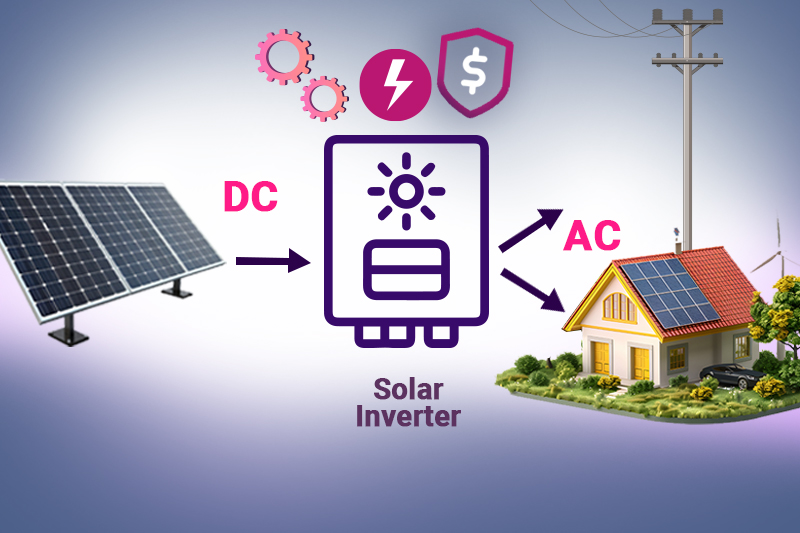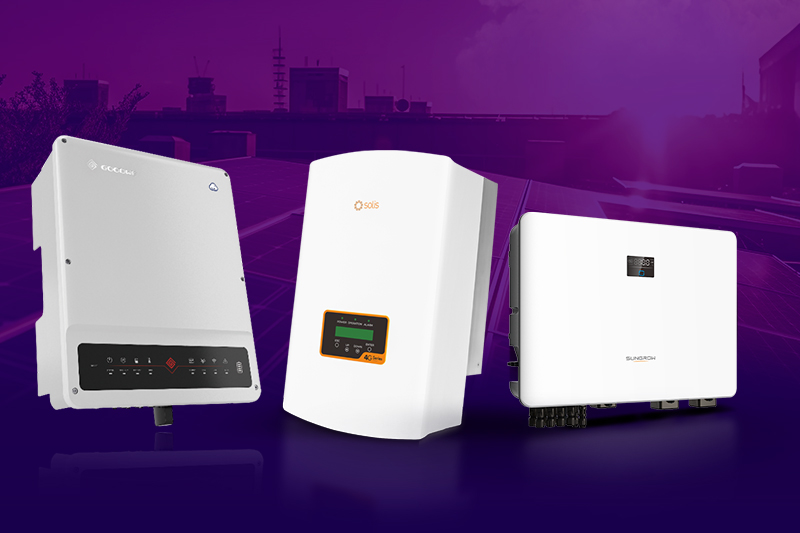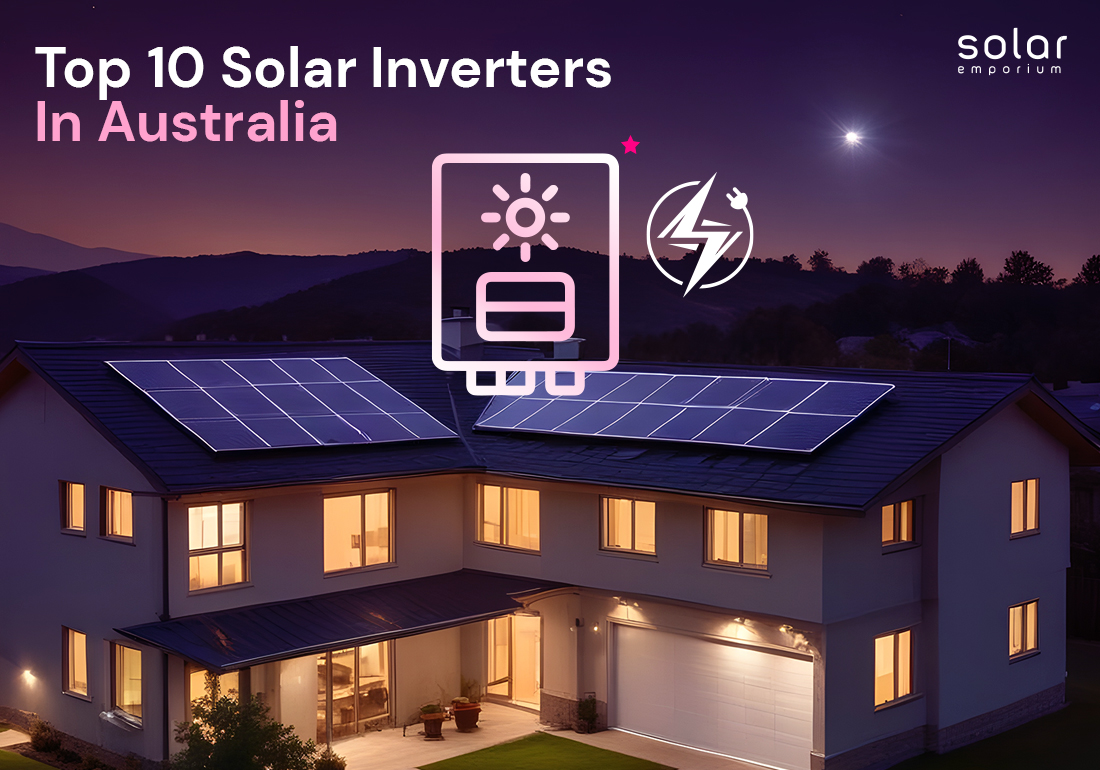A crucial component of a solar panel system, a solar inverter converts direct current (DC) electricity from solar panels into the alternating current (AC) electricity that powers your home’s lights and appliances.
In 2024, Australia boasts a range of high-quality inverters known for their reliability and top-notch performance, providing homeowners with security and confidence in their investment.
If you’re wondering which one is best for you, we’ve listed the top 10 solar inverters in Australia available from solar retailers to help you choose the right one for your needs.
What is a Solar Inverter Used for?
Functioning as the heart of a solar energy system, an inverter is a device that transforms the direct current (DC) generated by solar panels into the alternating current (AC) used in your home. It is often the most advanced part of the solar panel system.
Solar panel systems require inverters to perform two essential tasks: converting DC to AC and Maximum Power Point Tracking (MPPT). Solar panels produce DC electricity, which the inverter must convert to AC because that’s your home’s electricity.
The amount of sunlight and the temperature of the solar panels change throughout the day, affecting their performance. This means the voltage and current produced by the panels can vary constantly.
The inverter uses Maximum Power Point (MPP) tracking to adjust and find the best combination of voltage and current to produce the most electricity possible.
Types of Inverters
String Inverter
String inverters are the most common type of solar inverter for homes. Usually, you only need one solar panel system. Multiple solar panels are connected to this inverter, changing the DC electricity to AC electricity for home use.
Micro-Inverter
Microinverters are small inverters that you need for each solar panel. They help each panel work at its best, even if part of your roof is shaded. If one microinverter stops working, the others keep changing DC to AC since each panel has its inverter.
Hybrid Inverter
A hybrid inverter, with its ability to work seamlessly with a battery in your solar power system, empowers you to send DC power to the battery and provide AC power to your home and the grid. This versatility puts you in control of your energy usage.

Central Inverter
Central inverters are used in large solar panel systems, like those for commercial buildings. They work like string inverters but on a bigger scale. All the solar panels connect in a combiner box, sending the DC power to the central inverter to convert it to AC.
Power Optimizers
Power optimisers are like microinverters but don’t convert DC to AC at the panel. Instead, they improve the DC power from each panel before sending it to a central string inverter.
This helps reduce performance issues from shading or mismatched panels. Power optimisers offer a good balance between the cost of string inverters and the performance of microinverters.
Where Should a Solar Inverter be Installed?
String, hybrid, and battery inverters should be installed on a shaded wall, usually near the main switchboard. While inverters are weatherproof and designed for outdoor use, excessive heat can reduce their performance and lifespan.
If a shaded area isn’t available, your installer should recommend mounting an awning over the inverter. Specialised awnings are available, and sometimes, weatherproof housing might be necessary.
Security is also essential. String inverters can be attractive to thieves if they are easy to access. Although theft is rare, installing the inverter behind a fence or locked area is best. Some models come with built-in anti-theft locking devices.
How to Determine the Best Solar Inverters

Max Efficiency
The efficiency of solar inverters is crucial because all the DC electricity from the solar panels must pass through the inverter to be converted into AC electricity for home use.
Inverters are tested by independent authorities, which provide maximum efficiency and European efficiency ratings on their product datasheets.
Most solar inverters have a maximum efficiency of 96.5% to 98%, with higher numbers indicating better efficiency.
Warranty
The warranty period differs by brand. We recommend choosing an inverter with at least a 5-year warranty, though a 10-year warranty is ideal. Some manufacturers offer extended warranties of up to 20 years, usually at an extra cost.
Selecting a brand with an Australian office and a local phone number is vital. An extended warranty from a company without an Australian presence is not very valuable. You can check the list of CEC-approved inverter brands with an Australian office.
If you don’t want to go through all the trouble, contact Solar Emporium. We can take care of everything for you.
PV Evolution Labs Top Performer
PV Evolution Labs (PVEL) has been testing solar panel reliability since 2014, and their tests are highly regarded internationally. You can review the list of PVEL Top Performers or check out the Inverter Scorecard.
Key Features
Also, consider each inverter’s unique features. For example, Enphase uses microinverters, and SolarEdge uses power optimisers, which improve their rankings.
These features allow for individual panel-level optimisation and monitoring, adding significant consumer value.
Top 10 Solar Inverters in Australia
The Australian market offers a variety of inverter brands. Some brands were identified as the best option and top performers, with positive reviews, and others were average.
In addition to these considerations, some inverters are known for their cost. Inverters are typically more expensive, but this is only sometimes the case.
If you want a long-lasting inverter, it will cost between 20 and 30 per cent of your solar panel system. Some inverter brands are market leaders due to their design, longevity, modernity, high efficiency, low complaint rate, and revamping.
Consequently, we’ve compiled a list of the best inverter brands to help you decide about your preferred or necessary quality inverter.
- Fronius Solar Inverter
- SMA Solar Inverter
- Huawei Inverter
- Growatt Inverter
- SAJ Inverter
- Enphase Solar Inverter
- Solar Edge Inverter
Our Best Sellers

1. Sungrow Solar Inverter
Our Sungrow inverter line-up offers the best of all string inverters. It has advanced features such as single-phase and three-phase functionality, compatibility with high-power and bifacial PV modules, and a comprehensive MPPT range. This information empowers you with knowledge about the latest technology in the solar industry.
They’re safe and reliable with an integrated arc fault circuit interrupter, Type II DC&AC SPD, and a corrosion protection rating of C5.
The setup is user-friendly with plug-and-play installation, easy access to the iSolarCloud monitoring platform, and a compact, heat-dissipating design. For intelligent management, it provides real-time data with 10-second updates, 24/7 live monitoring online and via its display, and online IV curve scanning and diagnostics.
All the products come with a warranty of up to 10 years. And Sungrow’s average efficiency ratings are a remarkable number of 98.5%
2. Solis Solar Inverter
Our Solis inverter line-up has all three phases: Hybrid, Single-phase, and Three-phase. All these inverters are perfect for home solar setups, especially the Hybrid ones. They’re super efficient at 97.5% and have a wide MPPT voltage range for capturing tons of energy. Invest in clean energy with a Solis hybrid inverter for a reliable power source that’s great for the future.
These inverters come with a 5-year warranty, which can be extended to 10 years (spare parts and labour). Their efficiency is a staggering 98.7%!
3. GoodWe Inverter
GoodWe has been one of our consistent and bestselling inverters. This reliable brand has single-phase and three-phase line-ups.
The single-phase inverters, ranging from 5-10kW, are an excellent choice for residential buildings. They come with 3 MPPTs, which means they handle complex rooftops well and boost power efficiency.
With a super low 50V startup voltage, these inverters get going earlier in the day and generate more power. They also support up to 20A DC max input per MPPT, making them perfect for high-power modules and helping to reduce costs over time.
Plus, they have an optional PID recovery function to keep your panels performing at their best. For added safety, you can get an optional Arc-Fault Circuit Interrupter (AFCI) and Type III Surge Protection Device (SPD) on both the DC and AC sides, which helps protect against electrical fires and lightning in harsh conditions.
Three-phase ones are also the top picks for homes and businesses because they’re packed with great features that make them super-efficient. It also offers extra safety with optional AFCI.
It’s a real game-changer with an impressive efficiency of 98.4% and solid oversizing and overloading capabilities. Plus, the plug-in AC connector makes setup and maintenance a breeze.
GoodWe offers a 5-year warranty on its on-grid inverters. Plus, for the DNS, DNS G3, MS, and MS G3 series inverters, you get an extra 5-year (60-month) spare parts warranty on top of the manufacturer’s original 5-year warranty.
Your access to all these reliable products is one click away! Click on Solar Emporium and get a free solar quote today!







